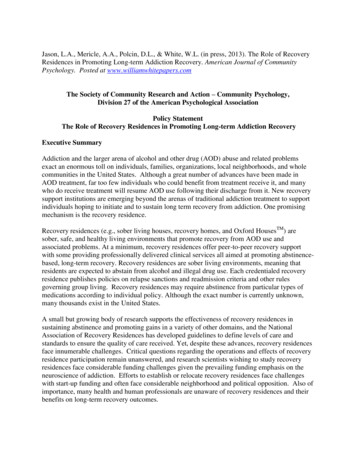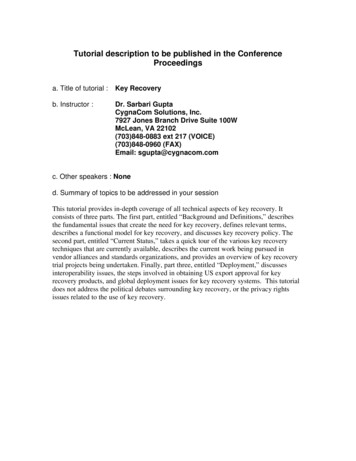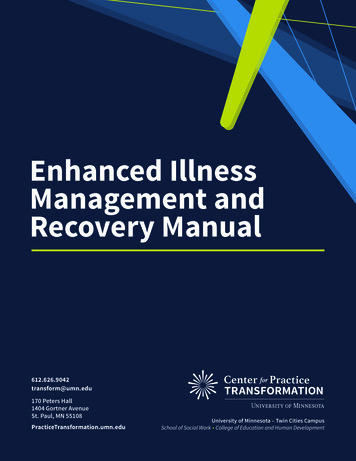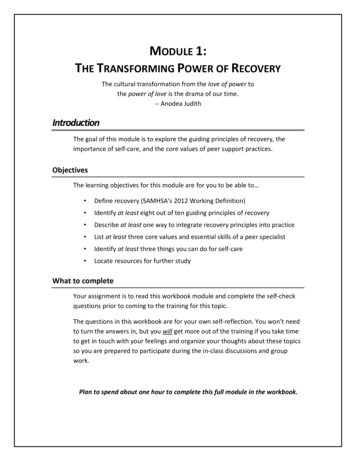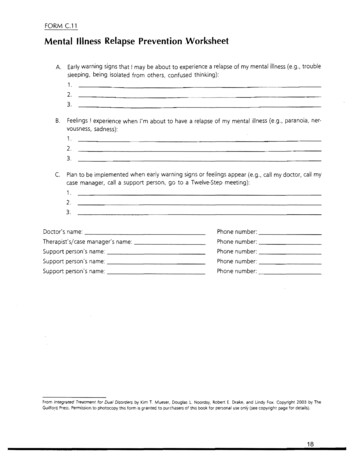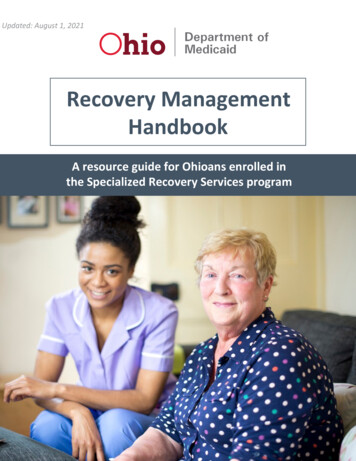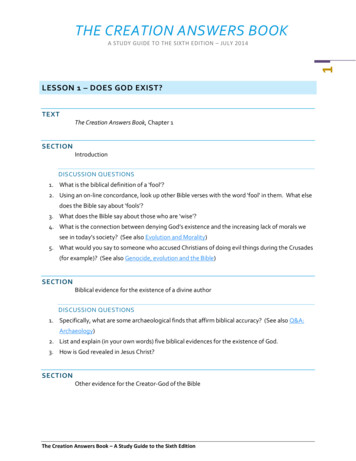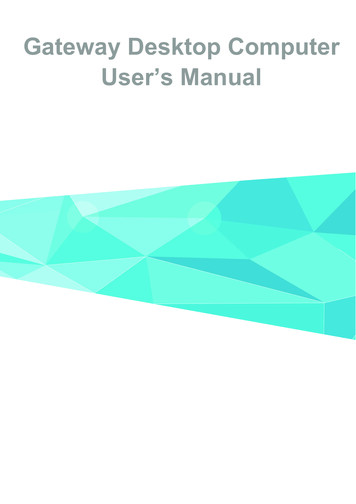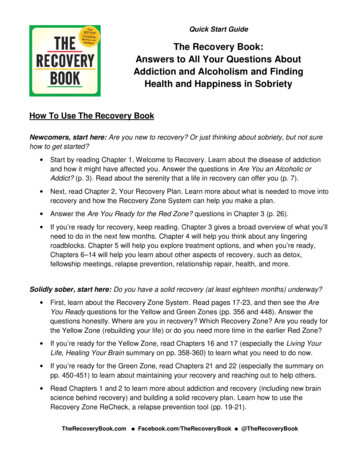
Transcription
Quick Start GuideThe Recovery Book:Answers to All Your Questions AboutAddiction and Alcoholism and FindingHealth and Happiness in SobrietyHow To Use The Recovery BookNewcomers, start here: Are you new to recovery? Or just thinking about sobriety, but not surehow to get started? Start by reading Chapter 1, Welcome to Recovery. Learn about the disease of addictionand how it might have affected you. Answer the questions in Are You an Alcoholic orAddict? (p. 3). Read about the serenity that a life in recovery can offer you (p. 7). Next, read Chapter 2, Your Recovery Plan. Learn more about what is needed to move intorecovery and how the Recovery Zone System can help you make a plan. Answer the Are You Ready for the Red Zone? questions in Chapter 3 (p. 26). If you’re ready for recovery, keep reading. Chapter 3 gives a broad overview of what you’llneed to do in the next few months. Chapter 4 will help you think about any lingeringroadblocks. Chapter 5 will help you explore treatment options, and when you’re ready,Chapters 6–14 will help you learn about other aspects of recovery, such as detox,fellowship meetings, relapse prevention, relationship repair, health, and more.Solidly sober, start here: Do you have a solid recovery (at least eighteen months) underway? First, learn about the Recovery Zone System. Read pages 17-23, and then see the AreYou Ready questions for the Yellow and Green Zones (pp. 356 and 448). Answer thequestions honestly. Where are you in recovery? Which Recovery Zone? Are you ready forthe Yellow Zone (rebuilding your life) or do you need more time in the earlier Red Zone? If you’re ready for the Yellow Zone, read Chapters 16 and 17 (especially the Living YourLife, Healing Your Brain summary on pp. 358-360) to learn what you need to do now. If you’re ready for the Green Zone, read Chapters 21 and 22 (especially the summary onpp. 450-451) to learn about maintaining your recovery and reaching out to help others. Read Chapters 1 and 2 to learn more about addiction and recovery (including new brainscience behind recovery) and building a solid recovery plan. Learn how to use theRecovery Zone ReCheck, a relapse prevention tool (pp. 19-21).TheRecoveryBook.com Facebook.com/TheRecoveryBook @TheRecoveryBook
Family, friends, and community leaders, start here: Are you concerned about a loved one ormembers of your community? Start by reading Chapters 1 and 2: Welcome to Recovery and Your Recovery Plan. You’lllearn about the disease of addiction and how it affects the brain and decisionmaking. TheAre You an Alcoholic or Addict questions on page 3 can help you determine if someonereally does need help. You’ll also learn about what it means to “live in recovery” and what ittakes to get there. The Recovery Zone System (pp. 17-23) in particular can help you tounderstand that recovery is a life-long process; it doesn’t happen overnight. Then turn to Chapter 26, For Friends and Family (p. 538), to learn about how addictionaffects the entire family and what you can (and can’t) do to help someone. Be sure to readGetting Help for Your Loved One, starting on page 543. If you are ready to look at treatment options, read Chapter 5, The Many Roads to aLifetime of Sobriety. It reviews all options, while Chapters 6-9 give more details on each.Health professionals, start here: Are you a health professional who helps people strugglingwith addiction? Start with Chapter 1, Welcome to Recovery, to learn more about the disease of addiction,how it affects the brain and body, and how recovery can heal the brain. Are You anAlcoholic or Addict? on page 3 will help you determine if someone really does need help. Read Chapter 2, Your Recovery Plan, to learn about what your patients need to do to getinto recovery, and how the Recovery Zone System can help them build a solid recovery. If you have patients who are ready to move into sobriety, read Chapter 3, Stop: ActivateYour Recovery, to help them navigate the early days of recovery. To help patients build a treatment plan, read Chapter 5, The Many Roads to a Lifetime ofSobriety. It reviews all options, while Chapters 6-9 give more details. To learn about the physical and mental health issues that can occur in various stages ofrecovery, read Chapters 13, 20, and 24. Chapter 25 covers options for quitting smoking. Be sure to read about the very serious risks of medication in recovery; see MedicationConcerns, pp. 290-293 and 475-481. Also see Nondrug Approaches to Common Medical Problems, starting on page 494(especially Pain Control, p. 513). Help your patients learn how to find good health information online; refer them to CallingDr. Google: How to Find Good Health Information, pp. 286-290. If you run a recovery group, you may want to assign sections or chapters as readinghomework. The entire group can then discuss the material the following week.TheRecoveryBook.com Facebook.com/TheRecoveryBook @TheRecoveryBook
The Recovery Book: The Recovery Zone SystemThe Recovery Zone System is a road map for a life in recovery. It gives clear guidelines on whenand how a person in recovery can address various areas of life—treatment, fellowship activities,relationships, education, career, finances, recreation, and health—now that he is striving to puthis life back on track. It helps him to know when he is ready to move forward in each of thoseareas. And it helps him to see when he might need to move back for a bit, to avoid a relapse.The Recovery Zone System divides life in recovery into three distinct Recovery Zones: Red,Yellow, and Green. It also includes the Recovery Zone ReCheck, a relapse prevention tool, andTAMERS, a device for helping your brain heal.The Recovery Zones (pp. 17-18; chart, pp.22-23) The Red Zone: Stop. Activate your recovery. For the first eighteen months or more ofrecovery, focus first and foremost on saving your life. Nothing else is as important. The Yellow Zone: Proceed with caution. Build your life. Once you have a solideighteen months or more of sobriety, you’ll move into the Yellow Zone, where you can putyour energy into building the life you deserve and making your existence more fulfilling. The Green Zone: Go. Celebrate your life. After you have a few solid years of sobrietyand have rebuilt your life, you’ll move into the Green Zone. Then it’s time to celebrate yourlife, do what you can to live a long and healthy life, and help others find recovery.The Recovery Zone ReCheck (pp. 18-21)The Recovery Zone ReCheck is an easy-to-use relapse prevention tool. It only asks you to takea focused inventory once a month or so, answer some basic questions, and then take actionbased on your answers.Your Brain in Recovery: TAMERS (pp. 11-13)TAMERS is a simple device that helps people in recovery remember what they need to do—every day—to use the power of neuroplasticity to heal their brains. Think about recovery, Talk about recoveryAct on recovery, connect with othersMeditate and Minimize stressExercise and Eat wellRelaxSleepTheRecoveryBook.com Facebook.com/TheRecoveryBook @TheRecoveryBook
[Chapters 3-15]plus:Chapter 1. Welcome to RecoveryChapter 2. Your Recovery Plan[3-4]Chapter 26. For Family and Friends[5, 6, 7][8-9][10][11][11][12][13][13][13] The Recovery Book / www.TheRecoveryBook.com[14]
[Chapters 16-20][Chapters 21-22][16-17][21-22][18][21, 22, 4][20][24] The Recovery Book / www.TheRecoveryBook.com
The Recovery Book: Table of Contents & Chapter Highlights1. Welcome to RecoveryWho Needs Recovery? What is Addiction? What is Alcoholism? Are You an Alcoholic orAddict? Is Drinking Damaging Your Body Already?Moving into Recovery How Did This Happen to My Brain? Your Brain in Addiction Your Brain in Recovery Heal Your Brain with TAMERS2. Your Recovery PlanThe Key Elements of Your Recovery Plan: Commit to Sobriety, Get Active in a MutualSupport Fellowship, Be Patient and Let Your Body and Brain Heal, Follow the RecoveryZone SystemThe Recovery Zone System: How it Works (Red Zone: Stop, Activate Your Recovery;Yellow Zone: Proceed with Caution, Build Your Life; Green Zone: Go. Celebrate Your Life),Recovery Zone ReCheck The Red Zone 3. Stop: Activate Your RecoveryAre You Ready for the Red Zone?Your Recovery Program in the Red Zone: Recovery Treatment; Mutual-Support Fellowshipand Spirituality; Living Sober and Preventing Relapse; Relationships, Recreation, andSober Socializing; Education, Career, and Finances; Physical Health, Diet, and Exercise;Mental HealthYour Brain in the Red Zone: Recovery Treatment; Mutual-Support Fellowship; LivingSober and Preventing Relapse; Relationships, Recreation, and Sober Socializing,Education, Career, and Finances; Physical and Mental Health4. Committing to RecoveryI Don’t Think I Have a Problem It’s Not My Fault It’s Too Hard to Quit I’m Not Ready There’s No One There Like Me OK, I’ll Go—But What Do I Tell Everyone? I’m Still WaryAbout Living SoberTheRecoveryBook.com Facebook.com/TheRecoveryBook @TheRecoveryBook
5. The Many Roads to a Lifetime of SobrietyYou Have Many Options It All Starts With Detox Quitting on Your Own AlcoholicsAnonymous and Other 12-Step Fellowships Other Mutual Support Groups OutpatientTreatment Help from a Sober Companion Inpatient Treatment Recovery Residences What About Therapy? What About Pharmaceutical Therapy? How to Find Treatment Who Will Mind the Kids? Treatment Confidentiality Paying for Treatment6. A Closer Look: Detox and WithdrawalBefore You Get Started A Guide to Detox and Withdrawal If You Detox at Home Detoxand Withdrawal Scenarios: Alcohol; Other Central Nervous System Depressants; Cocaine,Crack, Methamphetamine, and Other Stimulants; Opiates/Narcotics; Marijuana and OtherHallucinogens; Antidepressants and Antipsychotics You Can Make it Through Detox Suicide Prevention and Crisis Intervention Lifelines7. A Closer Look: Inpatient TreatmentShould I Consider Inpatient Treatment? What Happens in Inpatient Treatment? LeavingTreatment The Recovery Zone System Continuing Care Plan8. A Closer Look: AA and Other 12-Step FellowshipsA Beginner’s Guide to AA and Other Fellowships Starting Your Fellowship-BasedProgram More Ideas for Working Your Program All About Sponsors9. A Closer Look: Twelve-Step Programs and YouCommon Issues of AA Beginners More About Spirituality and Religion Everyone isWelcome at 12-Step Fellowships10. First Steps: Living in Sobriety and Preventing RelapseMoving into Your Lifetime of Sobriety Sober-Living Homes and Sober Helpers Avoid aRelapse—Resist Temptation Avoid a Relapse—Deal with Cravings and Compulsions IThought I Would Be Happy by Now Clean Up Your Online Life What If I Slip?11. First Steps: Relationships, Recreation, and Socializing in the Red ZoneRebuilding Relationships Repairing the Family Issues with Your Partner SexualIntimacy What About a New Relationship? Sober SocializingTheRecoveryBook.com Facebook.com/TheRecoveryBook @TheRecoveryBook
12. First Steps: Education, Work, and Finances in the Red ZoneYour Professional Life Getting Back into a Work Routine Legal and Financial Troubles13. Your Physical Health in the Red ZoneYour Health Priorities Now Calling Dr. Google: How to Find Good Health Information Medication Concerns A Healthy Lifestyle The Clean and Sober Diet for the Red Zone Should I Exercise Now? Common Health Issues in Early Recovery14. Your Mental Health in the Red ZoneCommon Lingering Symptoms Mental Health and Emotional Issues Getting Healthy15. For Teens and Young Adults in RecoveryAre You Ready to Change? Fitting in When You’re In Recovery Working Things Out The Yellow Zone 16. Proceed with Caution: Build Your LifeAre You Ready for the Yellow Zone? Living Your Life, Healing Your Brain RecoveryZone ReCheck17. Your Recovery Program in the Yellow ZoneKeep Working Your Program Reach Out to Help Others Now How to Be a GoodSponsor Common Issues in the Yellow Zone Heading Off a Relapse If You Relapse18. Rebuilding Your Life: Relationships, Recreation, and Socializing in the Yellow ZoneIs It Time to Make Changes? Renewing Relationships Rebuilding Family Ties Common Relationship Issues Having Fun Again Finding a New Relationship19. Rebuilding Your Life: Education, Work, and Finances in the Yellow ZoneAre You Ready to Make Career Changes? Fixing Finances20. Your Health in the Yellow ZoneYour Health Priorities Now Medication Concerns A Healthy Lifestyle Clean and SoberDiet for the Yellow Zone Exercise Mental HealthTheRecoveryBook.com Facebook.com/TheRecoveryBook @TheRecoveryBook
The Green Zone 21. Go: Celebrate Your LifeAre You Ready for the Green Zone? Living Your Life, Healing Your Brain RecoveryZone ReCheck22. Your Recovery Program in the Green ZoneSticking with Recovery Keep Helping Others—It Helps You Too Be a Recovery Activist23. Raising Substance-Free KidsAll Kids Are at Risk for Addiction How to Addiction-Proof Your Child Protect Your KidsOnline24. Your Health in the Green ZoneYour Health Priorities Now Medication Concerns Your Healthy Lifestyle: The Clean andSober Diet Exercise Nondrug Approaches to Common Medical Problems25. Time to Quit SmokingOn Your Mark: Deciding to Quit Get Set: Preparing to Kick the Habit Go: Quit Day26. For Family and FriendsHow Addiction and Alcoholism Affect Relationships Getting Help for Your Loved One Should We Do an Intervention? If They Won’t Stop When Your Child Is in Trouble Treatment for Teens Understanding the Zones of Recovery—And Your Role in Each Your Concerns, Actions, and Emotions Al-Anon and Other Support Fellowships Rebuilding Your Family—Or Not RelapseTheRecoveryBook.com Facebook.com/TheRecoveryBook @TheRecoveryBook
Read Chapter 2, Your Recovery Plan, to learn about what your patients need to do to get into recovery, and how the Recovery Zone System can help them build a solid recovery. If you have patients who are ready to move into sobriety, read Chapter 3, Stop: Activate Your Recovery, to help them navigate the early days of recovery.


